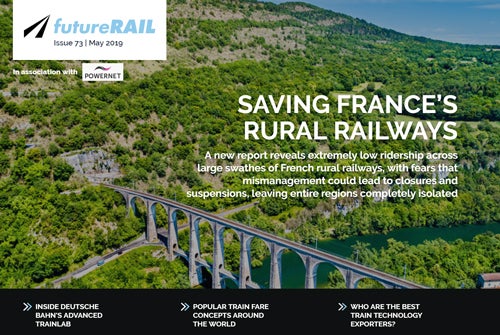
A report into the condition and usage of almost 9,000km of France’s railways painted a bleak picture about the prospects of the country’s rural lines, highlighting high running costs and extremely low ridership rates. We ask: what does the future look like for these railways, and can they ever be saved?
Earlier this year, Deutsche Bahn unveiled its latest innovation: the Advanced TrainLab, a four-car laboratory vehicle available to the rail sector across Germany for testing futuristic digital technologies. We profile the specialist train to find out what features it’s currently testing out.

Discover B2B Marketing That Performs
Combine business intelligence and editorial excellence to reach engaged professionals across 36 leading media platforms.
We also look at the state of Spanish railways, after the European Commission issued a formal notice to Spain for failing to meet EU requirements for rail safety, and ask: is there something rotten at the core of Spanish rail accident investigations?
Finally, we round up the world’s top rail technology exporters, as well as the most popular train fare concepts, and talk to the Institution of Mechanical Engineers about the state and future of hydrogen on UK’s railways.
Read the issue in full here.
In this issue
Rail exports: which countries export the best train technologies?
While the UK and the US dominated the train technology market for decades, their prestige is now declining as new leaders emerge. Which countries are currently the best exporters of rail technology and why? Adele Berti finds out.
Read the article here.

US Tariffs are shifting - will you react or anticipate?
Don’t let policy changes catch you off guard. Stay proactive with real-time data and expert analysis.
By GlobalDataInside Deutsche Bahn’s Advanced TrainLab testing vehicle
Deutsche Bahn has unveiled the advanced TrainLab, a four-car laboratory vehicle available to the rail sector across Germany for testing innovative digital technologies. Julian Turner reveals how it is able to put innovations like 5G, sensor and obstacle detection and real-time train localisation to the test.
Read the article here.
Saving France’s rural railways: is there a light at the end of the tunnel?
A report into the state and future of almost 10,000km of French railways was handed to the government at the end of March. The review assessed the usage and prospects of several regional lines in France that account for 15% of costs, despite having extremely low ridership. What does the future look like for these railways and can they ever be saved? Adele Berti investigates.
Read the article here.
Transforming Old Oak Common into an HS2 super-hub
HS2 has revealed new designs of what a revamped Old Oak Common station will look like in 2026, as part of a wider plan to create the best-connected rail interchange in the UK. The new station will be built on an existing railway depot, south of Willesden Junction station, and will be a nexus in a wider regeneration scheme for the area. Chris Lo takes a look at the designs.
Read the article here.
Have Spanish rail incident investigations been compromised?
In January, the European Commission issued a formal notice to Spain for failing to meet EU requirements for rail safety. Specifically, it alleges inadequacies in the methods used when investigating railway accidents and incidents. Is there something rotten at the core of Spanish rail accident investigations, asks Patrick Kingsland.
Read the article here.
Bon voyage: a look at popular train fare concepts around the world
From Citymapper’s new, all-inclusive London pass to Germany’s one-day ticket to travel anywhere in the country, what are the most popular fare options in the world? Adele Berti looks at the top examples.
Read the article here.
Does hydrail work in the UK?
The Institution of Mechanical Engineers is campaigning for the adoption of hydrogen trains for non-electrified lines in the UK. Adele Berti talks to Dr Jenifer Baxter, head of engineering at the institution, who explains when hydrogen should and should not be used and how it can help the UK Government achieve its target of phasing out all diesel trains by 2040.
Read the article here.
A first in rail: Eurotunnel rolls out facial recognition tech
The Eurotunnel is to become the first non-airport border crossing to deploy biometric technology at its terminal in anticipation of longer queuing times post-Brexit. Kicking off in April, facial recognition gates will be installed at select terminals, with a wider launch to follow. How will the technology be rolled out, and where does it fit in the wider preparations Eurotunnel is making in anticipation of Brexit? Chris Lo finds out.
Read the article here.
Next issue | June 2019
In our June issue, we profile an eagerly-awaited project, namely Texas’ upcoming high-speed rail, which will mark the debut of high-speed services on US soil.
On the other side of the world, Italy is divided over a fraught high-speed project of its own, the Turin-Lyon railway, which has sparked civil unrest and passionate political promises on both sides of the argument.
We also talk to the Association of British Commuters, which on this year’s International Women’s Day staged a protest against driver-only trains, arguing that the safety of women and vulnerable passengers is put at risk once the guard is removed from the carriages.
Finally, we take out five key takeaways from the EU’s digitalisation report and look at the four winners of Network Rail’s Automated Infrastructure Design competition.





